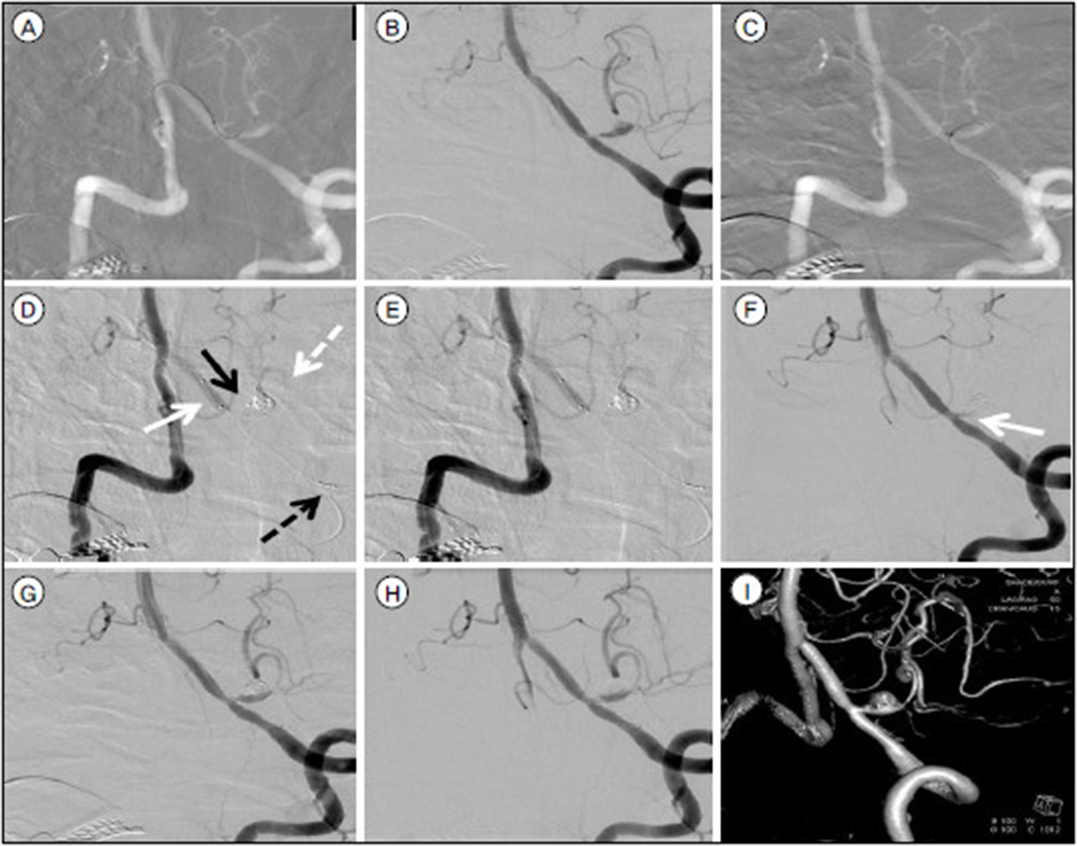J Cerebrovasc Endovasc Neurosurg.
2018 Dec;20(4):235-240. 10.7461/jcen.2018.20.4.235.
Coil Embolization of Ruptured Proximal Posterior Inferior Cerebellar Artery Aneurysm with Contralateral Retrograde Approach for LVIS Jr. Intraluminal Support Deployment
- Affiliations
-
- 1Department of Neurosurgery, St. Vincent's Hospital, College of Medicine, The Catholic University of Korea, Suwon, Korea. jaehoonsung@gmail.com
- KMID: 2461922
- DOI: http://doi.org/10.7461/jcen.2018.20.4.235
Abstract
- The safety and feasibility of simple coil embolization and stent deployment for the treatment of posterior inferior cerebellar artery (PICA) aneurysms, as well as their radiologic and clinical results, have not been adequately understood. Especially, if dissecting aneurysm of proximal PICA is associated with small caliber PICA and stenosis of ipsilateral vertebral artery orifice (VAO), endovascular coiling with saving of PICA is not always easy. This 64-year-old man presented with subarachnoid hemorrhage due to a ruptured dissecting aneurysm of left proximal PICA. The aneurysm was irregularly fusiform in nature with a shallow PICA orifice (1.4 mm) and narrow caliber (0.9-1.5 mm). Moreover, the ipsilateral VAO showed severe stenosis (1.8 mm). We performed bifemoral puncture and chose additional route from right vertebral artery to left vertebrobasilar junction for retrograde approach and deployment of LVIS Jr. intraluminal support at proximal PICA. And then, the antegrade approach and coiling of aneurysm was done. Despite of transient thrombus of PICA, the aneurysm was successfully secured with preservation of whole PICA course. For preservation of narrow PICA with ipsilateral VAO stenosis, the contralateral approach and deployment of LVIS Jr. intraluminal support may be considered.
MeSH Terms
Figure
Reference
-
1. Al-khayat H, Al-Khayat H, Beshay J, Manner D, White J. Vertebral artery-posteroinferior cerebellar artery aneurysms: clinical and lower cranial nerve outcomes in 52 patients. Neurosurgery. 2005; 56(1):2–10.
Article2. Cross DT 3rd, Moran CJ, Derdeyn CP, Mazumdar A, Rivet D, Chicoine MM. Neuroform stent deployment for treatment of a basilar tip aneurysm via a posterior communicating artery route. AJNR Am J Neuroradiol. 2005; Nov-Dec. 26(10):2578–2581.3. Jeon SI, Kwon BJ, Seo DH, Kang HI, Park SC, Choe IS. Bilateral approach for stent-assisted coiling of posterior inferior cerebellar artery aneurysms - two cases. J Cerebrovasc Endovasc Neurosurg. 2012; 09. 14(3):223–227.
Article4. Kim MJ, Chung J, Kim SL, Roh HG, Kwon BJ, Kim BS, et al. Stenting from the vertebral artery to the posterior inferior cerebellar artery. AJNR Am J Neuroradiol. 2012; 02. 33(2):348–352.
Article5. Lv X, Jiang C, Li Y, Wu Z. Clinical outcomes of ruptured and unruptured vertebral artery-posterior inferior cerebellar artery complex dissecting aneurysms after endovascular embolization. AJNR Am J Neuroradiol. 2010; 08. 31(7):1232–1235.
Article6. Mazur MD, Kilburg C, Wang V, Taussky P. Pipeline embolization device for the treatment of vertebral artery aneurysms: the fate of covered branch vessels. J Neurointerv Surg. 2016; 10. 8(10):1041–1047.
Article7. Peluso JP, van Rooij WJ, Sluzewski M, Beute GN, Majoie CB. Posterior inferior cerebellar artery aneurysms: incidence, clinical presentation, and outcome of endovascular treatment. AJNR Am J Neuroradiol. 2008; 01. 29(1):86–90.
Article8. Roh HG, Chun YI, Choi JW, Cho J, Moon WJ, Solander S. Retrograde stent placement for coil embolization of a wide-necked posterior inferior cerebellar artery aneurysm. Korean J Radiol. 2012; Jul-Aug. 13(4):510–514.
Article9. Song HH, Won YD, Kim YJ, Kim BS. The endovascular management of saccular posterior inferior cerebellar artery aneurysms. Korean J Radiol. 2008; Sep-Oct. 9(5):396–400.
Article10. Suh SH, Kim BM, Chung TS, Kim DI, Kim DJ, Hong CK, et al. Reconstructive endovascular treatment of intracranial fusiform aneurysms: a 1-stage procedure with stent and balloon. AJNR Am J Neuroradiol. 2010; 01. 31(1):155–160.
Article
- Full Text Links
- Actions
-
Cited
- CITED
-
- Close
- Share
- Similar articles
-
- Technical Consideration for Coiling of Ruptured Proximal Posterior Inferior Cerebellar Artery Aneurysm
- Flow diversion via telescoping stent with Low-profile Visualized Intraluminal Support Junior for treatment of ruptured dissecting aneurysm located at proximal posterior inferior cerebellar artery
- Persistent Trigeminal Artery with a Cerebellar Branch and Trigeminal-Cavernous Fistula from Ruptured Aneurysm: Transarterial Coil Embolization
- Retrograde Stent Placement for Coil Embolization of a Wide-Necked Posterior Inferior Cerebellar Artery Aneurysm
- Coil Embolization of Ruptured Thrombosed Distal Superior Cerebellar Artery Aneurysm: A Case Report



